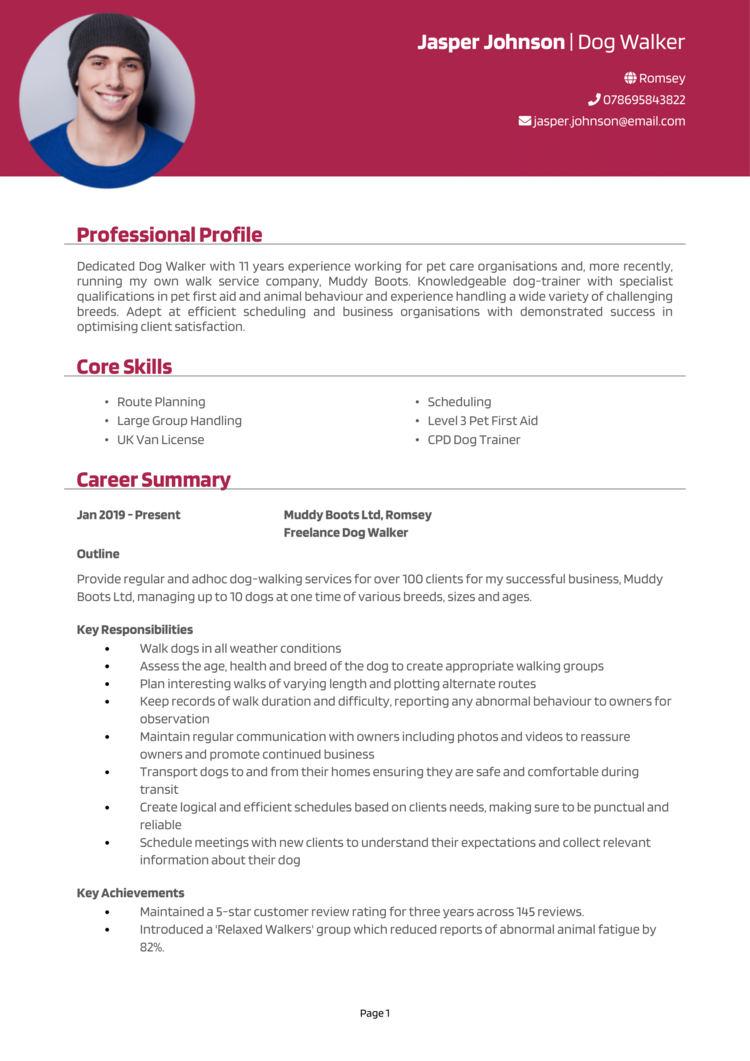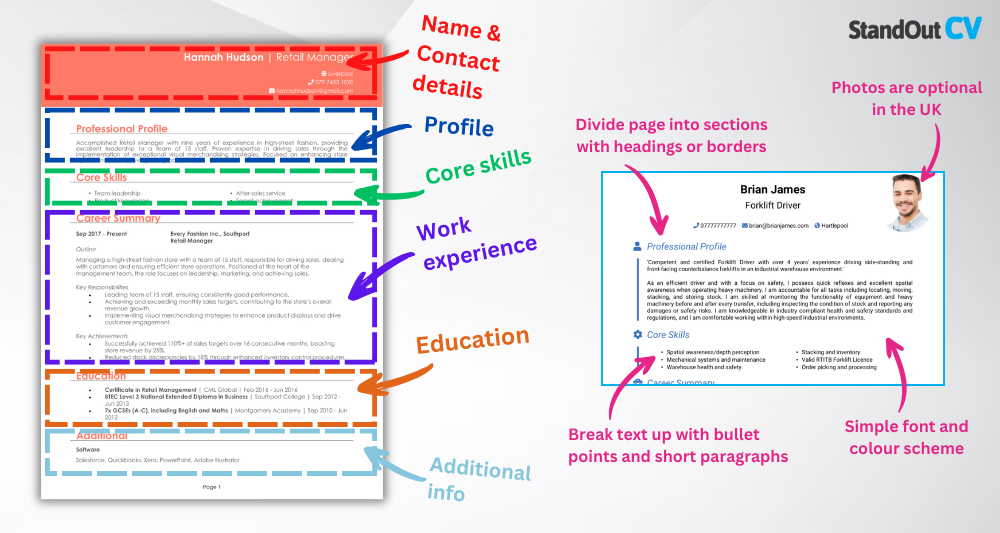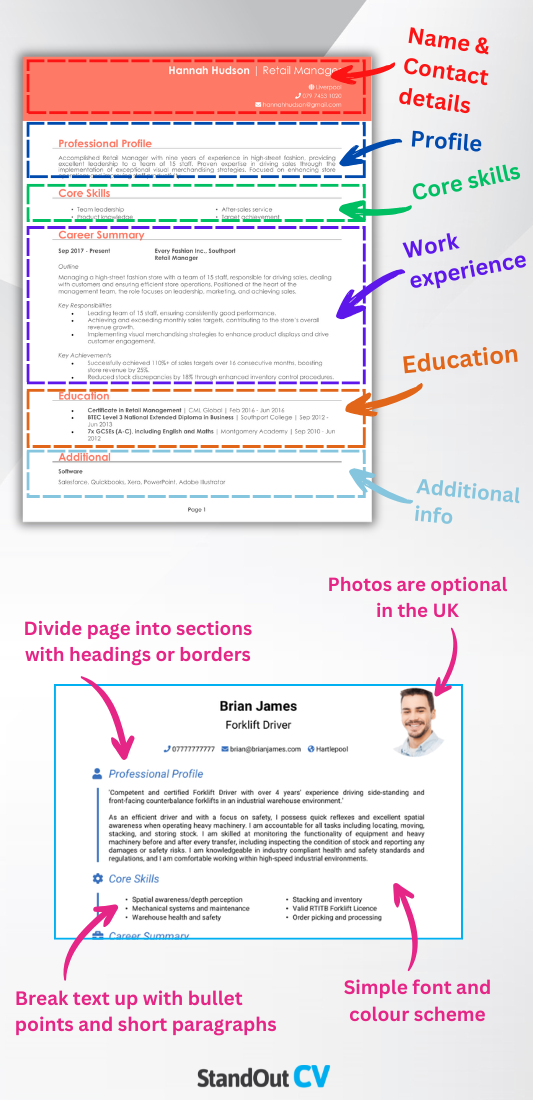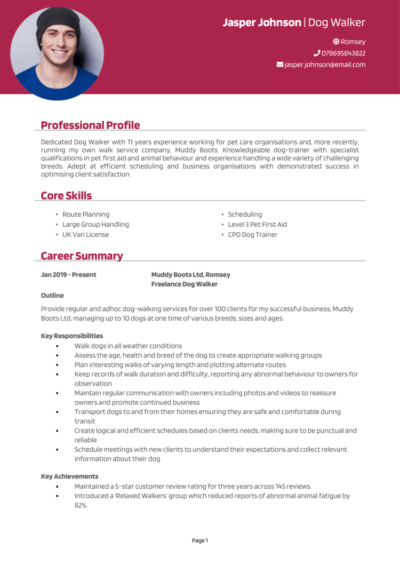Rain or shine, you’ve got your lead in hand, route mapped, and tail-wagging clients ready to go.
It’s time to put your reliability and pet-handling skills into a CV that works as hard as you do.
This guide and its Dog Walker CV example will help you show you’re not just good with dogs – you’re great with communication and trust.
Dog Walker CV

How to write your Dog Walker CV
Discover how to craft a winning Dog Walker CV that lands interviews with this simple step-by-step guide.
Being a dog walker isn’t a walk in the park. Owners are trusting you with a member of their family – and that means your CV needs to show not just pet-handling skills, but care, reliability, and good judgement.
Whether you’re applying through an agency or offering your own services, you’ll soon write a CV which fetches results.
How should you structure and format a Dog Walker CV?


Just like a walk, a CV should have a clear route from start to finish. A good structure makes it easier for the reader to follow your skills, see your experience, and trust that you’re organised and professional. Visual mistakes or making these details hard to find will just make the reader move onto the next applicant.
Here’s the layout to follow:
- Name and contact details – Keep your name and personal details front and centre at the top. Whether or not to include a photo is your decision.
- Profile – Start with a snapshot of your skills, career highlights, and professional aspirations.
- Core skills – Focus on core skills like making it easy for employers to see your key strengths at a glance.
- Work experience – Walk through your professional experience, beginning with your latest position and moving backwards.
- Education – Outline your education and certifications, focusing on those most relevant to the role.
- Additional info – This section is optional, but it’s a good place for interests and hobbies that complement your CV.
Your format matters, too. Keep your CV length to two pages max, use bullet points to make dense text easy to read, and use clear headings to separate each part. Choose a professional font and make sure there’s plenty of white space – no one wants to get lost in a big block of text. The clearer your layout, the quicker they’ll trust you know what you’re doing.
Writing a Dog Walker CV profile


Your CV profile is the friendly introduction at the top of your CV – just a short paragraph that explains who you are, what experience you’ve had, and why someone should trust you with their beloved pet. It’s about showing you’re friendly and dependable enough to convince recruiters to hire you.
Dog Walker CV profile examples
Profile 1
Experienced Dog Walker with over 10 years managing daily walking schedules for clients across urban and suburban areas. Trusted by pet owners for reliable, safe, and caring service tailored to individual dog needs and temperaments. Familiar with GPS tracking apps, dog first aid, and multi-dog handling techniques.
Profile 2
Reliable Dog Walker with five years of experience supporting busy professionals and elderly pet owners in maintaining their pets’ daily routines. Adept at managing reactive breeds, working in all weather conditions, and ensuring dogs are exercised, enriched, and safely transported. Uses pet care software to schedule and update clients.
Profile 3
Enthusiastic Dog Walker with two years of experience working with a boutique pet care service. Known for building strong bonds with animals and offering personalised care for puppies, elderly dogs, and rescues. Skilled in using GPS walk trackers and providing real-time photo updates to owners.
Details to put in your Dog Walker CV profile
Here’s some tips on what to include:
- Where you worked – Describe the settings you’ve worked in, such as private homes, local pet services, dog walking companies, or kennels.
- Your top qualifications – Mention if you’ve completed any animal care courses, pet first aid training, or dog behaviour workshops.
- Essential skills – Highlight the practical abilities you use every day, such as managing multiple dogs, using leads and harnesses, handling difficult behaviour, or sticking to client routines.
- Clients or animals supported – Say how many dogs you walk at once, whether they’re big, small, reactive, or shy – and if you also manage feeding, medication or vet visits.
- Value delivered – Show how you build trust with owners, keep animals safe, and offer reliable service – even in bad weather, unexpected situations, or tight schedules.
Writing an effective core skills section


Your skills section should offer a quick snapshot of the abilities that make you a reliable, capable dog walker. Instead of listing soft traits like “friendly” or “animal lover,” focus on the tangible, job-specific skills that pet owners and agencies will care about. Think about what’s in the job advert – then reflect that in your section.
Whether it’s handling different breeds, following feeding routines, responding to emergencies, or managing client communication, this section should reflect the practical side of the work you do.
The top skills to highlight in your Dog Walker CV
- Route Planning and Time Management – Organising efficient walking schedules and routes tailored to each dog’s needs and energy levels.
- Canine Behaviour Monitoring – Observing and managing dog behaviour during walks to ensure safety and proper socialisation.
- On-Leash Control and Handling – Using appropriate leashes, harnesses, and commands to maintain control in various environments.
- Health and Safety Awareness – Identifying signs of illness or injury and responding promptly to emergencies or environmental hazards.
- Multi-Dog Walk Coordination – Managing groups of dogs safely and calmly while maintaining individual attention and control.
- Client Communication and Updates – Providing regular feedback, photos, or updates to clients about their dog’s wellbeing and activity.
- Pet First Aid Knowledge – Applying basic first aid techniques in case of injury or health incidents during walks.
- Weather and Terrain Adaptability – Adjusting walk plans according to weather conditions and safe walking environments.
- Secure Pick-Up and Drop-Off Protocols – Following agreed procedures for accessing homes and ensuring dogs are safely returned.
- Understanding Breed-Specific Needs – Tailoring walk intensity, pace, and duration to suit different breeds and individual temperaments.
Showcasing your work experience


This is where you show that you haven’t just walked the walk – you’ve done it regularly, responsibly, and with great feedback. Whether you’ve worked solo or with a company, cared for dogs full-time or part-time, this is your chance to explain how you gained your experience and what you’ve learned.
List your most recent work experience first and work backward. Start each job entry with a short sentence summarising who you worked for and what kind of work you did, then use bullet points to break down your main duties and achievements. Focus on what owners or employers valued – punctuality, handling complex dogs, managing multiple bookings, or maintaining trust over time.
Writing job descriptions for past roles

- Outline – Summarise the dog walking company or client type, what areas you covered, and the scale of your work.
- Responsibilities – Use action words like “walked” and “managed.” For example: “walked up to four dogs per session, following strict feeding and medication routines” or “managed regular daily visits for long-term clients.”
- Achievements – If you helped grow the client base, built trust over time, or received great feedback, include it. Even small wins – like 100% on-time bookings – show professionalism.
How to present past roles for Dog Walkers
Dog Walker | Paws & Pace Pet Services
Outline
Provided daily dog walking and pet check-in services across a large client base in a London borough. Worked for a well-established dog walking company known for reliable care and tailored services for dogs with different needs and temperaments.
Responsibilities
- Walked up to six dogs per session, ensuring safety, positive behaviour, and social compatibility
- Planned walking routes through parks and green spaces based on weather and dog age
- Used GPS tracking apps to provide real-time walk updates and route logs for owners
- Carried out basic health checks and reported behavioural or physical concerns to clients
- Cleaned up after dogs and followed specific instructions for on-leash or off-leash protocols
Achievements
- Maintained a 100% client retention rate over two years through punctuality and consistent service
- Reduced no-shows and miscommunications by introducing automated scheduling reminders
- Received over 50 five-star reviews on pet care platforms
Dog Walker | UrbanTailz Collective
Outline
Supported dog owners in a busy inner-city neighbourhood, offering flexible walking and feeding services through an independent pet care co-operative. Focused on trust, communication, and safety across all sessions.
Responsibilities
- Created weekly walking plans for over 20 clients based on each dog’s needs and exercise goals
- Handled anxious and reactive dogs using positive reinforcement and behaviour guidance
- Provided midday walks for owners working from home or in offices
- Updated owners after every walk with photos, comments, and timestamps
- Worked collaboratively with two other walkers to cover sick days and holiday schedules
Achievements
- Helped a rescue dog client transition from solo walks to small group walks within six weeks
- Increased bookings by 40% through referral programmes and consistent client updates
- Coordinated a dog social event that helped raise brand visibility and client engagement
Dog Walker | Barkridge Pet Companions
Outline
Worked in a rural village setting providing one-on-one walks and pet care for elderly dogs, puppies, and reactive breeds. Part of a small team offering premium, tailored dog walking services.
Responsibilities
- Managed solo and dual walks based on energy level, health, and behaviour history
- Assisted owners with basic training reinforcement during walks
- Monitored hydration and offered enrichment toys during house visits
- Transported dogs safely using crates and harnesses in personal vehicle
- Kept detailed logs of each visit including time out, toilet breaks, and behaviour notes
Achievements
- Reduced cancellations by 50% by introducing flexible booking policies and SMS updates
- Built a strong local reputation, receiving 15 new client referrals in under six months
- Helped two elderly dogs maintain mobility through gradual increase in walk duration and terrain variety
Highlighting your education


Even if you didn’t study animal care, this section still matters. It shows your general education and work ethic – and if you’ve taken any courses relevant to dogs or small business management, even better.
List your qualifications from most recent to earliest. That might include GCSEs, diplomas, pet first aid certificates, or anything else relevant. There’s no need to go into lots of detail – just show that you’ve got the basics, and that you’re always open to learning more.
The best qualifications to boost a Dog Walker CV
- City & Guilds Level 2 Certificate in Animal Care – A great foundation for anyone working with pets or in animal services
- Pet First Aid Training (e.g. Dog First Aid Company or ProPet First Aid) – Shows preparedness and responsibility in emergencies
- Level 3 Diploma in Animal Management – Offers more in-depth knowledge for those wanting to build a long-term animal care career
- CPD-certified Dog Walking or Pet Sitting courses – Often short and flexible, great for part-timers or beginners
- Animal Behaviour short courses – Useful for managing tricky dogs or understanding canine body language





